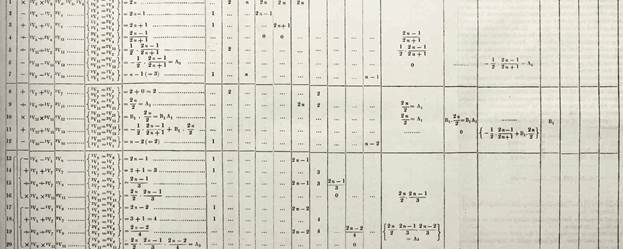
"Note G" on the analytical engine is Ada's written program for calculating Bernoulli's series. I won't go into details as it's pure mathematics, except to say that the history of it goes back to Pythagoreans who laid pebbles on beaches..

..forming a triangle, and then placed a second triangle against it..

Dividing the rectangle by two to get the number of pebbles per triangle.
1+2+3+n = n(n+1)/2
ie, here it would be:
1+2+3 = 3(3+1)/2
= 6
This is just the start of the journey, which involves finding sums of powers (1 to the power 2 or 3 etc). It's pure mathematics, whereby a series has differences, and the differences have differences.
All series have a type of rhythm to them, although the rhythm can be weird (like Bruce Lee's broken rhythm). All along I've been saying that numbers are ego, whereas a series is obviously something that appears on nature (like Fibonacci).
Yes, but it's cleat nature isn't only number; it's balance and proportion. It's true that anything can be number - like the atomic numbers of elements - but there has to more or we would just be robots.
What is there is primal rhythm, and numbers are linked to it in some way. Mathematical series are somehow linked to primal rhythm so are interesting in that way.
It's when numbers become pure information that they attract the calculating ego. The Lovelace program in nothing to do with that and is just elegant, reminding me a bit if CC Beck's cross-stitch patterns!
I read a bit on it, and it has a loop (a repeat procedure); notations for variables; and a counter variable. Someone ran it on C and found it had a minor glitch; he said that proved it was "genuine" and not foolish around.
It's not do much that an interest in numbers implies ego, as that the Black Sun of illusion implies physical boredom, and hence a numerical compulsion of the ego (see Grace Slick quote HB62/2).
Ada Lovelace came from a romantic family, and this was before the era of Darwin, a competitive order. A competitive order is an illusion of the head that exists in a universe of straight lines (sun).
Animals only compete in a physical universe of primal rhythm. A fish consists if backbone and muscle, and spends its life exercising the two. Things are vastly more simple and yet elegant and flexible than "they" tell us.
Numbers are attached to all this - counting that is - because that's the nature if rhythm.
In other words, numbers can be organic, or they can be machine-oriented. The "switch" (P111,112) has been from the universe as organism (body) to the universe as machine (head, algorithm).
Ada Lovelace's algorithm is really more towards the universe as organism and really nothing to do with numbers as information.
Could that be why she's downplayed compared to Babbage? I don't know, but do know information is all "they" care about, from their perspective of an illusory Black Sun of physical boredom and sterile calculation.
Did you see Trump storming out proclaiming "the numbers of employed are up"? He is only able to think in terms of numbers, either " good" or "bad". This is exactly what the illusion of the modern order is. Numbers have some relation to reality, but reality is not number, it is rhythm. The Pythagoreans, with their musical appreciation, may have had a similar mystical connection.
After all, numbers are not "things"; movement and balance are things (physical). Byron is writing about the world of things ("words are things") that appear in the sky as a product of rhythm (Earthspin).
He died at Missolinghi while supporting the Greek cause against the Turks. His epics are quite Greek, having the physical presence of night, and the dark, romantic values of feminine beauty.
Darkness is the destruction of light, and therefore the destruction of perspective and straight lines (logic and all that goes with it).
In other word, romantic darkness has a revolutionary aspect. It is primal rhythm, that the universe is composed of. It is the physical action of the proportionate physique, running through forests full of game. It is the body in balance, as opposed to the head.
Byron, perhaps like Jack Traylor and others, had romantic doubts about the new world of Galileo and Newton. Taylor's poem "Pets" is back in HB56. introducing the next song on the Jefferson Starship Roswell CD, he says
"This is an old revolutionary song..not that I am recommending that."
Nighttime is also the ending to day. With an end, with finality, comes destiny and remembrance, else all is null and void. The Black Sun of sterility.
'Tis vain to struggle- let me perish young-
Live as I lived, and love as I have loved;
To dust if I return, from dust I sprung,
And then, at least, my heart can ne'er be moved. (Stanzas to the Po, verse 13)
The function of art is not to challenge our knowledge, that meagre corpus of answers we have managed to intuit from the experience of a few millennia of mortal history. Rather, the aim of art is to challenge the questions, to quell the analytical faculty of mind from swallowing everything up to indecision and rationalusm, by presenting ultimate versions of those intuited truths, some lasting witness of a final rest for things, some kiss yo debunk the Grand Inquisitor. The artist is finality. "All the good ideas have already been thought," says Goethe; "the point is to try to think them again.".. The final way of writing of the war, the final depiction of the Crucifixion, this is what the artist pursues, this is what challenges. The same goes for comics; fan drawings are always trying to "get" the essence if Batman, the writers to top their best story.. Finality, not "expansion", is the drive of art, and of its real expansion thereby. (John Clifton, TCJ #90, 1984)
Home







